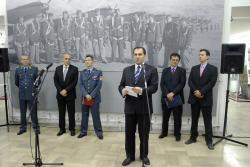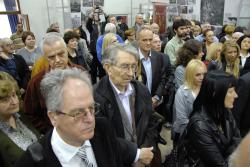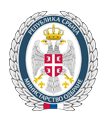- About MoD
Minister and Associates
- Minister
- State Secretary
- Assistant Ministers
- Secretary of the Ministry of Defence
Sectors
- Defence Policy Sector
- Human Resources Sector
- Material Resources Sector
- Budget and Finanance Sector
- Sector for Infrastructure and Hospitality Services
- SAF
- Documents
- Services
- Sport
- Archive
- Contacts
06.04.2011.
Exhibition April 1941 opened in the Military Museum
 On the occasion of 70th anniversary of the attacks of the Axis Powers on the Kingdom of Yugoslavia, in the presence of State Secretary Igor Jovicic, members of the Minister of Defence staff and Chief of the Army of Serbia, Belgrade representatives of cultural and historical institutions and the history lovers, an exhibition of the "April 1941" by Predrag Lazetic was opened today in the Military Museum.
On the occasion of 70th anniversary of the attacks of the Axis Powers on the Kingdom of Yugoslavia, in the presence of State Secretary Igor Jovicic, members of the Minister of Defence staff and Chief of the Army of Serbia, Belgrade representatives of cultural and historical institutions and the history lovers, an exhibition of the "April 1941" by Predrag Lazetic was opened today in the Military Museum.After the opening statements of the Director of the Military Museum Colonel Miroslav Knezevic, an exhibition was opened by State Secretary Igor Jovicic, noting that the attack on Yugoslavia, which began in the early hours on 6 April 1941 had been launched without the declaration of war.
- During WWII, some 870 thousand people grouped in 59 divisions participated in combat operation on the one hand opposed by a poorly technically equipped, politically divided and betrayed Army of the Kingdom of Yugoslavia, which numbered about 600 thousand soldiers. Belgrade was bombed during the first day by 484 bombers escorted by 250 fighters. The resistance of the Yugoslav Air Force was amazing compared to the number of bombers they had to oppose. Although surprised by the numbers of enemy aircraft, the Yugoslav pilots bravely engaged in dog fights. The river flotilla put up an impressive resistance to German troops, especially the monitor "Drava" that shot down and caused damage to dozens of German aircraft. Unfortunately, under the attacks of German bombers and armored units, the Army of the Kingdom of Yugoslavia was forced to withdraw - said Igor Jovicic.
 Noting that the exhibition "April 1941” is a description of these fateful days in the Kingdom of Yugoslavia, as State Secretary Igor Jovicic said remarking that the exhibition shows the fate of officers, NCOs and soldiers of the Army of the Kingdom of Yugoslavia.
Noting that the exhibition "April 1941” is a description of these fateful days in the Kingdom of Yugoslavia, as State Secretary Igor Jovicic said remarking that the exhibition shows the fate of officers, NCOs and soldiers of the Army of the Kingdom of Yugoslavia. - Part of them were captured and taken to concentration camps, and some, particularly naval and air officers, continued to fight in Africa and the Mediterranean countries in the anti-Hitler coalition. In the country, a significant part of the Army of the Kingdom of Yugoslavia did not recognize capitulation and continued fighting in the resistance movement for the liberation of Serbia and Yugoslavia. Attending the exhibition makes us realize how precious peace is -as Secretary of State said.
Exhibition "April 1941” was prepared in cooperation with the Museum of the Yugoslav Air Force and other museums in Serbia and abroad.
- About MoD
- Jurisdiction
- Organisation scheme
- Description of duties
- Minister and Associates
- Minister
- State Secretary
- Assistant Ministers
- Secretary of the Ministry of Defence
- Sectors
- Defence Policy Sector
- Human Resources Sector
- Material Resources Sector
- Budget and Finanance Sector
- Sector for Infrastructure and Hospitality Services
- Special Internal Units
- Secretariat
- Office of the Minister of Defence
- Military Attorney's Office
- Administrative Bodies within MoD
- Defence Inspectorate
- Military Intelligence Agency
- Military Security Agency
- Autonomous Departments
- Public Relations Department
- Military Healthcare Department
- Higher Education Institution
- Defence University
- Specific internal units
- Inspector General of the Services
- Internal Audit Section
- SAF
- Documents
- Services
- Sport
- Archive
- Contacts

